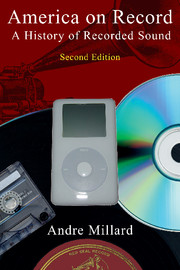Book contents
- Frontmatter
- Dedication
- Contents
- Preface to the second edition
- Preface to the first edition
- Introduction
- Part One The acoustic era
- Part Two The electrical era
- 6 The machines
- 7 Competing technologies
- 8 Empires of sound
- 9 Swing and the mass audience
- 10 High fidelity at last
- 11 Rock'n'roll and the revolution in music
- 12 The record
- 13 The studio
- 14 Perfecting studio recording
- 15 The cassette culture
- Part Three The digital era
- Abbreviations used in the notes
- Notes
- Select discography
- Select bibliography
- Subject index
- Recordings index
- Motion picture index
7 - Competing technologies
from Part Two - The electrical era
Published online by Cambridge University Press: 05 February 2015
- Frontmatter
- Dedication
- Contents
- Preface to the second edition
- Preface to the first edition
- Introduction
- Part One The acoustic era
- Part Two The electrical era
- 6 The machines
- 7 Competing technologies
- 8 Empires of sound
- 9 Swing and the mass audience
- 10 High fidelity at last
- 11 Rock'n'roll and the revolution in music
- 12 The record
- 13 The studio
- 14 Perfecting studio recording
- 15 The cassette culture
- Part Three The digital era
- Abbreviations used in the notes
- Notes
- Select discography
- Select bibliography
- Subject index
- Recordings index
- Motion picture index
Summary
The competition between cylinder and disc, and lateral and hill-and-dale cut, had been fierce, but it paled in comparison to the threat of a new technology which appeared in the mid-1920s. Not since Edison's invention of the phonograph had the American public been so excited about a new entertainment technology as it was about radio. “In all the history of inventing nothing has approached the rise of radio from obscurity to power,” announced one popular magazine. The “radio craze” was a devastating blow to an already depressed industry which had barely survived the postwar depression of the early 1920s. It was not a threat of improved reproduction but of a new method of delivering the same entertainment. The music heard on the radio was free, and the listener had access to a library of music that was beyond the resources of all but the most determined record collector.
Radio had been originally conceived as a method of telegraphing without wires; by the early twentieth century, it was used to send messages to ships at sea with Morse code. But in the same way that telegraphy gave way to telephony, the wireless telegraph developed into a technology that could transmit the sound of speech through the air to millions of homes. Some inventors saw beyond the point-to-point transmission of radio messages to the transmission of music to an infinite number of listeners. The independent inventor Lee De Forest must be given the credit for the idea of using radio waves to broadcast information and music, although he was not the first to play music over the air waves. Reginald Fessenden, who had once worked for Edison at the West Orange laboratory, had achieved that feat in 1906 with an experimental transmission from Brant Rock, Massachusetts. De Forest's dream of broadcasting, the “invisible empire of the air” as he called it, was demonstrated in an extraordinary experiment carried out in 1910 in New York City.
- Type
- Chapter
- Information
- America on RecordA History of Recorded Sound, pp. 136 - 157Publisher: Cambridge University PressPrint publication year: 2005



